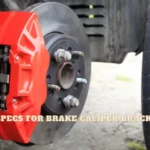For each type of vehicle, a corresponding recommended torque specification exists. You can always find the required torque spec in the vehicle owner’s manual for the individual pump you are using, which you should check because specifications vary by make, model, and year. However, let’s get into details about torque specs for a water pump.
What is a Torque Spec?
Torque is the amount of rotational force applied at the application site. Torque standards are the amount of force advised on the hardware to ensure correct installation when mounting a wheel to a vehicle. A water pump shouldn’t require a torque wrench. Just tighten the nuts until the gasket is completely sealed.
An excellent technique is to progressively tighten each bolt instead of tightening them all at once in a circular pattern. Although not required, it is ideal if you have never handled a spanner before.
Your car’s water pump needs torquing for a couple of reasons and there are torque specifications. While you don’t need a torque wrench for the water pump, you’ll need to tighten the bolts to ensure the gaskets are firmly in place. This way, the gasket won’t leak. Care must be taken not to tighten the bolts hurriedly and in a circular pattern. Rather, you should do it in a cross pattern.
What are the Torque Specs For a Water Pump?
To determine the torque specs for your water pump, you will need to carry out two different critical tests. First, you’ll need to measure the torque and angle to a particular tension. Secondly, there’s also measuring torque and bolt angle to failure.
What does each test aim to achieve? Measuring torque to bolt angle to failure seeks to determine installation torque and evaluate how the bolt joint performs. In this test, several varying run-downs are performed to determine a torque spec. It requires graphing torque vs. angle of rotation to ascertain the amount of torque needed to reach the bolt’s yield strength.
On the other hand, measuring the torque and angle to a particular tension is intended to estimate the relationship between torque and tension. This test may be impractical in certain instances, depending on the structure and material of the joints.
The amount of torque on your cylinder head also matters. Typically, you should apply 7-9 foot-pounds of tension to each bolt while 12 to 14 foot-pounds of torque should go to each bolt.
This table shows the perfect torque specs for a water pump.
| Part | Bolt Size | Maximum Torque |
| Water Pump Bolts | 3/8”-16 | 27.12Nm (20 ft. lbs.) |
| Thermostat Housing | 3/8″-16 | 47.45Nm (35 ft. lbs.) |
| Oil Filter bolt | 1/2″-13 | 40.67Nm (30 ft. lbs.) |
| Starter Bolts | 3/8″-16 | 47.45Nm (35 ft. lbs.) |
Sometimes you want to tighten the starter bolts firmly but are unsure how firmly it should. The process is simple. You should align the starter motor with the engine and tighten the upper and lower bolts by hand. Alternatively, tighten the top bolts between 21 and 27 N-m (16-19 lb-ft).
How Powerful was the Buick Skylark’s Engine?
The 215-cubic-inch V8 was tuned to produce 190 horsepower (140 kW) at 4800 rpm. The Skylark Special was the first American vehicle to use a V6 engine in mass production in 1962, and it was named Vehicle of the Year by Motor Trend.
If you’re using a Buick model, for example, the axle nut of the car depends on the model.
| Buick Allure | Buick Axle Nut Torque |
| 2016-2017 | 150Nm (111ft-lbs |
| 2013-2017 | 37Nm (50 ft-lbs) |
| 1992-1995 | 103Nm (140ft-lbs) |
However, for the 2016-2017 model, you can back off by 45o before retightening to about 250Nm or 184 ft-lbs. You can turn extra 20 degrees for the 1992-1995 models.
What are the Torque Specifications for a Buick Engine?
For the majority of engines, post-tightening is required, in which case the bolts must be torqued once more to the desired value after the engine reaches maximum operating temperature. In specific circumstances, it is required to use Perfect Seal sealing compound (Buick component #980456) on the bolts.
Frequently Asked Questions
How is Torque Run-Down Determined?
To make contact, the nut or bolt should be turned down to about a half-turn (the washer is still loose). Add to the total the amount of torque needed to move the nut one last time before making contact.
How Do You Check Torque?
Make a mark on the application and fastener that have been tightened. Apply gentle pressure to the tool in the tightening direction until the fastener makes its first movement. The reading that was taken is a reliable reflection of the initial torque that was applied to the joint. The most effective approach to calculating residual torque is this.
How tight should a water pump bolt be?
They ought to fit snugly. Use your calibrated elbow to tighten till it is, then spin an additional 1/8th turn. Progressively tighten both bolts until they are snug. Never over-tighten one bolt before doing the other.
Should the bolts on a water pump be torqued?
A water pump shouldn’t require a torque wrench. Just tighten the nuts until the gasket is completely sealed. An excellent technique is to progressively tighten each bolt instead of tightening them all at once in a circular pattern.
What is starting torque of a pump?
It depends on your car’s make and model. Typically, however, the torque transmitted by the shaft coupling during run-up is known as the starting torque (see Start-up process). It is determined using a rotational speed function that is based on the power-to-angular velocity ratio (P/).
What torque requirements are there?
Torque standards are the amount of force advised on the hardware to ensure correct installation when mounting a wheel to a vehicle. For a variety of reasons, it is important to adhere to correct torque specifications. An excessive amount of torque can lead to over-tightening, which has serious repercussions.
Final Thoughts
Now that you have thorough information about the torque specifications of your car water pump, you shouldn’t have any issues. But your car owner’s manual should be the first guide. Overall, I hope you find this article helpful. Perfect auto maintenance is crucial and you don’t want to take chances for safety reasons.



